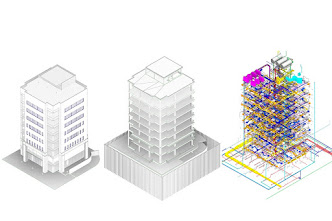Architectural BIM for Contractors: Essential Tools and Tips for Success in AEC Projects
In today’s competitive construction landscape, contractors and subcontractors are increasingly relying on Building Information Modeling (BIM) to streamline project workflows and boost productivity. BIM isn’t just a trend in the Architecture, Engineering, and Construction (AEC) industry—it’s a game-changer. For contractors and construction firms in the USA, understanding and using Architectural BIM effectively can be the difference between meeting project milestones and exceeding them. Let's look at some essential BIM tools, key benefits, and practical tips that can set contractors up for success in AEC projects.
1. Why Contractors Need Architectural BIM in AEC Projects
Architectural BIM provides contractors with an integrated, data-rich digital representation of a project, covering every detail from design to construction. It includes everything from Architecture CAD Drawing and Architectural 3D Models to advanced Architectural 3D Rendering Services, allowing for improved visualization and planning. Contractors using BIM gain a clearer understanding of the design intent and can more effectively manage project elements like materials, schedules, and budgets.
With tools like Revit Architecture Services and Architecture BIM Services, contractors can make informed decisions that reduce the risk of costly rework and delays, enhancing overall project efficiency. This shift is crucial in a rapidly evolving AEC industry where staying ahead is often tied to adopting these next-generation BIM Modeling Services.
2. Key BIM Tools for Contractors
Here are some of the most impactful BIM tools and technologies that every contractor should consider integrating:
Revit Architecture Services
Revit is one of the most widely used BIM platforms, especially for its advanced capabilities in Architectural BIM Modeling and documentation. Revit allows contractors to view and manipulate 3D architectural models, analyze them for constructability, and collaborate closely with designers and subcontractors.
- Benefits: Real-time collaboration, dynamic updates, and highly detailed architectural modeling.
- Best for: Complex AEC projects requiring intense coordination between multiple trades and frequent design modifications.
Navisworks for Clash Detection
Navisworks enables contractors to detect potential conflicts within a model before construction begins. This pre-construction analysis helps minimize clashes and enables teams to solve issues virtually, cutting down on expensive site modifications.
- Benefits: Improved accuracy, early detection of design conflicts, and seamless communication with stakeholders.
- Best for: Large-scale projects where multiple disciplines (such as MEP, structural, and architectural) intersect.
Architectural 3D Modeling and Rendering Services
3D modeling and rendering enhance the visualization of project details, making it easier for contractors to understand the overall look, feel, and design intent. Using Architectural 3D Rendering Services can also help contractors communicate plans with clients, subcontractors, and stakeholders who may not have technical knowledge.
- Benefits: Enhanced project presentations, improved client communication, and realistic project visualization.
- Best for: Client-facing presentations, design reviews, and early-stage project approvals.
3. Tips for Effective BIM Implementation for Contractors
To get the most out of Architectural BIM, contractors should focus on a few strategic actions:
Collaborate Early with Stakeholders
Collaboration is critical for successful BIM implementation. By working closely with architects, engineers, and other stakeholders from the start, contractors can ensure that everyone has access to the Architectural 3D Models and Architecture CAD Drawings necessary for effective decision-making. This early alignment can streamline workflows and reduce misunderstandings down the line.
Invest in BIM Training and Education
BIM technology is powerful, but using it effectively requires some level of expertise. For contractors, offering training on BIM platforms like Revit and Navisworks can enhance project outcomes and ensure smoother implementation.
Use BIM Data to Improve Decision-Making
BIM platforms like Revit provide comprehensive data, from material specifications to scheduling information. By leveraging this data, contractors can make informed decisions that positively impact project timelines and budgets.
- Pro Tip: Utilize BIM data for predictive analytics, especially when forecasting project schedules or estimating material requirements.
Streamline Coordination with Architectural BIM Services
Coordinating between trades can be challenging, particularly on large-scale projects. Architectural BIM Services allow contractors to keep all aspects of a project—from design updates to material orders—well-coordinated and accessible in real time. By having an updated, shared BIM model, contractors and subcontractors can avoid costly reworks and stay on track with project timelines.
4. Reaping the Benefits of BIM: Case in Point
Imagine a commercial construction project that uses Architectural 3D Modeling Services to create a detailed virtual model. Contractors can see exact placements of structural elements, HVAC, electrical, and plumbing installations, reducing the likelihood of onsite errors. Additionally, with regular updates in Revit Architecture Services, any changes to the Architectural BIM model are reflected immediately across the team, ensuring everyone is on the same page.
The benefits for contractors are significant:
- Enhanced precision in construction plans and minimized errors.
- Better resource allocation by using data-driven insights.
- Improved client communication with realistic 3D visualizations and renderings.
5. The Future of BIM in the Construction Industry
As the AEC industry evolves, so too will BIM technology. Contractors who adopt Architectural BIM Modeling today position themselves for a future of greater efficiency, sustainability, and innovation. With tools that enable more detailed and collaborative project planning, contractors can expect fewer disruptions, enhanced project quality, and ultimately a stronger reputation in the industry.
In Summary
For contractors and subcontractors aiming to succeed in AEC projects, Architectural BIM is a must-have. It empowers teams with actionable data, high-quality 3D visualizations, and streamlined workflows, ensuring that every project phase—from design and planning to construction and handover—goes smoothly. By integrating Revit Architecture Services, Architecture BIM Services, and Architectural 3D Rendering Services, contractors can unlock the full potential of BIM for better project outcomes.
Investing in BIM tools and training, collaborating early, and leveraging data effectively are foundational steps contractors can take to lead in the AEC industry. Embrace the power of BIM today to set your firm up for success tomorrow.



Comments
Post a Comment